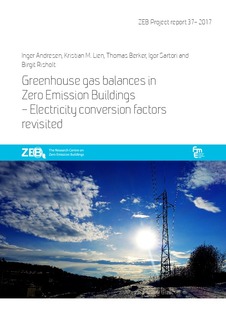| dc.description.abstract | Reduction of energy use and GHG emissions in the building sector is a high priority. The EU 2050 roadmap that was established in 2010, states that to achieve a global warming of less than 2°C in this century, Europe should reduce its GHG emissions by 80 % by 2050, using 1990 emissions as the reference. The roadmap shows that it is the power sector and the building sector that face the most severe reductions, with emission reductions of around 90%.
The Norwegian research centre for Zero Emission Buildings (ZEB) was established in 2008, with the objective to "develop competitive products and solutions for existing and new buildings that will lead to market penetration of buildings that have zero GHG emissions of greenhouse gases related to their production, operation and demolition" (www.zeb.no). According to the ZEB Centre, a building may be defined as a Zero Emission Building when all the GHG emissions from the entire life cycle of the building are compensated by GHG emission credits from the generation of renewable energy. However, the calculation of the life time compensation of greenhouse gas emissions in ZEBs involves a number of difficult issues, and has been subject to extensive discussions among the ZEB researchers and among different professions. A central issue is the methodology for calculating the carbon emission credits for electricity use and generation, and how the generation of renewable energy in the operation phase should be valued with respect to offsetting the embodied carbon emissions from the production of the building. Since buildings have a life time of several decades, this involves the stipulation of the future carbon intensity of grid electricity. Another issue is how to balance the historic emissions from the production of materials against the future GHG emission offset of the renewable energy surplus from the operation phase of the building.
These issues are elaborated on in the report. It includes a review of previous work and methods that have been applied in the ZEB Centre, with focus on the calculation of embodied emissions and the conversion factor for electricity in the operation phase. It also gives an overview of different methods and approaches for establishing emission credits from electricity use and generation, as well as related policy measures for GHG abatement. It discusses how to balance historic GHG emissions vs future emission credits, and challenges of the exchange of electricity between ZEBs and the grid.
A key challenge of the center has been to produce innovations within the inherent space of uncertainty given by the related frontiers of the research. Thus, a research strategy for the ZEB centre has been to maximize the incentives for the development of different solutions that reduce the overall GHG emissions connected to a building. If the GHG emission credits favour only one solution to reach a zero emission balance, then the result may be easier to reach in the present. However, given the fundamental uncertainty of future developments, preparing only for one route to reach the goal is a risky navigational strategy. On the other hand, if the conversion factor is chosen in a way so that a zero emission balance is impossible to reach in the present no matter which solution is chosen, then interesting research may be the result, but the industry will be very unlikely to participate in the construction of an “impossible” building. Thus, on must find a balance between assumptions about the future that discourage innovation completely and assumptions that lead to only one innovation. The experiences from the pilot building projects within the ZEB center show that reaching the highest levels of ambition for ZEB is very challenging, given the boundary conditions and the applied CO2-factor for grid electricity. The analyses and discussion indicate that the CO2-factor that have been used in the ZEB pilot projects probably does not “favor” energy measures on ZEBs compared to other measures for CO2-mitigation. Nevertheless, such a challenging CO2-factor have promoted innovation in that it has spurred the teams to reach further than they otherwise would have done, resulting in new solutions being implemented and tested out. As such, the chosen CO2-factor may be said to have served its purpose. | |
